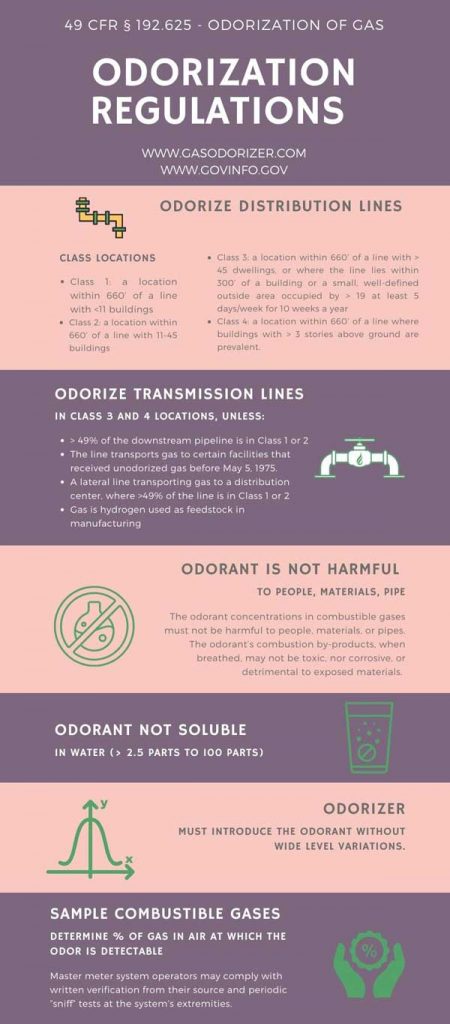Which gas lines need odorization? The Federal Pipeline Safety Regulations (§192.625) demand that combustible gases in some pipelines be odorized or contain a natural odorant. Those pipelines are distribution lines and some transmission lines.
 Natural Gas Odorization Requirements
Natural Gas Odorization Requirements
Distribution Lines
Distribution lines are local natural gas utility systems that include gas mains and service lines. They also include single lines serving a consumer operating at less than 20% SMYS (specified minimum yield strength) from a transmission line. Additionally, systems transporting LPG through a trailer park would be considered a distribution line. All distribution lines need to be odorized or contain natural odorants.

The natural gas odorization requirements (192.625) demand that combustible gases be odorized (or contain a natural odorant).
Transmission Lines
In the regulations, there are class location codes associated with population density. This designation has to do with the number of dwellings located within 220 yards (on both sides) of a pipeline for one mile or the land and building use within a hundred yards of the pipeline. Transmission pipelines in Class 3 and Class 4 locations require odorization. However, there are some exemptions.
A Class 3 location is a zone where 46 or more buildings are intended for human occupancy within an area (220 yards on both sides) of one mile on a pipeline. Alternatively, a Class 3 Location is a zone occupied by 20 or more people for one mile (220 yards on both sides) of the pipeline, at least five days per week for ten weeks in a given year.
A Class 4 location is an area where buildings with four stories or more are prevalent within 220 yards on both sides of a gas line.
Exemptions
Transmission lines in Class 3 and Class 4 locations must be odorized unless they meet one of the following exceptions:
- At least 50% of the pipeline downstream is a Class 1 or Class 2 location (<46 buildings).
- The line delivered gas to an exempted facility before May 5, 1975. These facilities may be an underground storage field, gas processing plant, or industrial plant using process gas that, if odorized, 1) could make the product unfit, 2) reduce the activity of a catalyst, or 3) reduce completion of a chemical reaction.
- When more than 50% of a pipeline lateral is in Class 1 or Class 2 locations, the line serves a distribution center (piping used to deliver gas for resale).
Gathering lines within cities or town limits must meet odorization transmission line requirements.
ODORIZATION – A REGULATORY PERSPECTIVE
By Edward E. Fant
Pipeline Specialist, Pipeline Safety Division
Transportation Safety Institute
Research and Special Programs Administration
U.S. Department of Transportation


